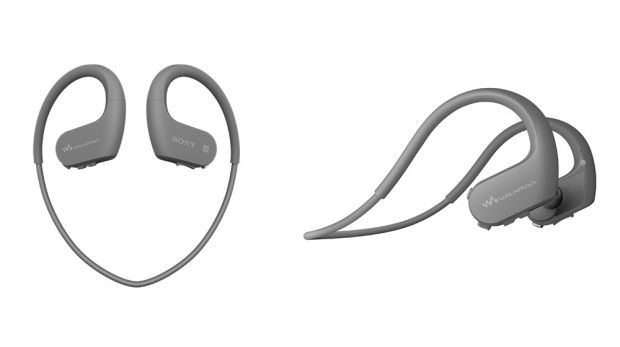You can trust Coach
I’ve got fond memories of the Walkman, especially the cassette version. (Less so the MiniDisc player – I’m still sore about that waste of time.) Now Sony has reconceived the Walkman for the modern age by shrinking the player, sticking it in a pair of headphones and, in a nod to the thing that did for the Walkman/MiniDisc/MP3 player, adding Bluetooth so you can take calls and stream from your all-powerful – whisper it quietly – smartphone.
It’s more than a small MP3 player, though. The headphones are suitable for swimming (rated IPX5/8, detailed feature fans) and while the buds are designed to form a seal in the ear, there’s an ambient noise mode which will funnel in the sounds of the world around you.
That’s an enticing offering, especially at £140 for the 4GB version, so I tried out the catchily titled NW-WS623s on the bike, on a run and in the pool to see if they’re a worthwhile alternative to a smartphone (or smartwatch with music storage) and Bluetooth headphones.
I started with a disappointingly quick session in the pool. The NW-WS623 come with two sets of earbud covers (with four sizes in each set). The pairs for the water have a seal to stop water leaking in and you can only use the music player – the headphones won’t connect to your phone via Bluetooth in the water.
Unfortunately, as soon as I put my head underwater when swimming, both with front crawl and breaststroke, the headphones were pulled off. The earbud housings are pretty big and it seemed the drag was enough to knock them out of place. I managed a couple of breast stroke lengths with my head above water and enjoyed the experience of swimming with music, but before long my neck started to ache and the headphones ended up placed by the side of the pool with my towel.
The remedy is to keep the headphones in place using the strap of a pair of goggles along the top of the earbud. Not across the earbud itself, though: the instructions warn you that because the earbud is designed to fit firmly in the ear and create a seal, the application of strong pressure can damage the ear or eardrum. Some waterproof headphones attach to goggle straps so I’m surprised these don’t. Many will probably be able to make these works (other reviewers have), but I remain unconvinced.
All is not lost though. Swimming isn’t the only watersport, of course, and if you’re into something like stand-up paddleboarding or canoeing, these give you a way to listen to music as you cruise along a waterway.
Sign up for workout ideas, training advice, reviews of the latest gear and more.
And there are several other reasons why the NW-WS623s are worth your time. My lugholes have always struggled with the fit of wireless Bluetooth headphones – I’ve tried all manner of different size tips, wings and fins, and I can guarantee one or both buds will fall out mid-activity, and they’re not going to stay in place if you have to put them back into a sweaty ear. So having an over-ear hook is a blessed relief and the simple silicone band that can be attached tightens the fit so they remained secure throughout a 40-minute steady run.

RECOMMENDED: The Best Running Headphones
The ambient sound mode is also a great feature for runs, ferrying noise through the casing and into the earbud, mixing it in with music. I couldn’t really tell the difference between the three levels of ambient assist while running, but while sitting in the gym before the run and fiddling with the settings, I was surrounded by some sort of PT group sales motivation session and it was delightful to go from hearing their chatter and whooping mixed in with my music to blocking the sound of them out entirely with the press of the button.
The feature isn’t foolproof though and Sony won’t guarantee that you’ll hear everything going around you perfectly, so I preferred to go with a loose fit when cycling my London commute. I could still hear the radio clearly though, beamed by Bluetooth from my phone without issue.
The sound on music is satisfactory, but I found the bass lacking, although that may be because I’m accustomed to the booming power boost function on the Fitbit Flyers.
The MP3 player part of the headphones is straightforward, although if you’re used to listening via your smartphone you may miss some functions. Chief among them is that you can’t skip to a particular album or playlist that you’ve loaded onto the player. Not surprising since there’s no screen, but it makes me think that it’s not worth upgrading the storage from 4GB (£140, good for 12 hours of music) to 16GB (£180) since skipping through hundreds of tracks to get to the one album you want feels like a faff, especially considering how easy it is to move music on and off of the headphones.

I used a MacBook and once I downloaded the content transfer software, I could drag and drop straight from iTunes into the Walkman’s window and each file was ferried over in a matter of seconds. There’s also an option to set up an automatic transfer folder on your computer to make it even more convenient. My only minor grumble is that the interface looks clunky, especially on a Mac – but whatever works, right?
This lack of polish carries over to the buttons, where Sony has ditched the three-button control common to most wired headphones and included eight. On the right casing there’s the power button, a play/pause button and a two-ended skip forward/back button. On the left, a mode button to skip through the three playback options (replay, shuffle, shuffle all), a button that activates Bluetooth pairing and cycles through the three ambient noise settings, and the volume button. I assume it’ll become second nature in the end, but it was too much for my poor brain and I had to keep referring to the instructions for an aide-mémoire.
The battery can last up to 12 hours (playing MP3s with ambient sound mode turned off) and there’s a quick-charge feature that will give you 60 minutes of playback by plugging in for just three minutes. Very impressive, although because there’s no voice notification of the battery life remaining, there’s still the risk you’ll run out of juice mid-activity.
Despite these niggles, we’re happy the Walkman hasn’t gone the way of the MiniDisc (*pours one out*). It provides a properly different option to the range of Bluetooth headphones that have only minor variations between them. Looking to run with music but don’t want to carry your phone or have an expensive smartwatch? Check them out. Like watersports and want to bring your tunes with you out on the water? Check them out. Struggle to find headphones that stay put? You get the idea.
4GB £140, 16GB £180, buy on sony.co.uk, check price on amazon.co.uk

Jonathan Shannon was the editor of the Coach website from 2016 to 2024, developing a wide-ranging experience of health and fitness. Jonathan took up running while editing Coach and used the training plans on the site to run a sub-40min 10K, 1hr 28min half marathon and 3hr 6min marathon. He’s an advocate of cycling to work and is Coach’s e-bike reviewer, and not just because he lives up a bit of a hill. He also reviews fitness trackers and other workout gear.

